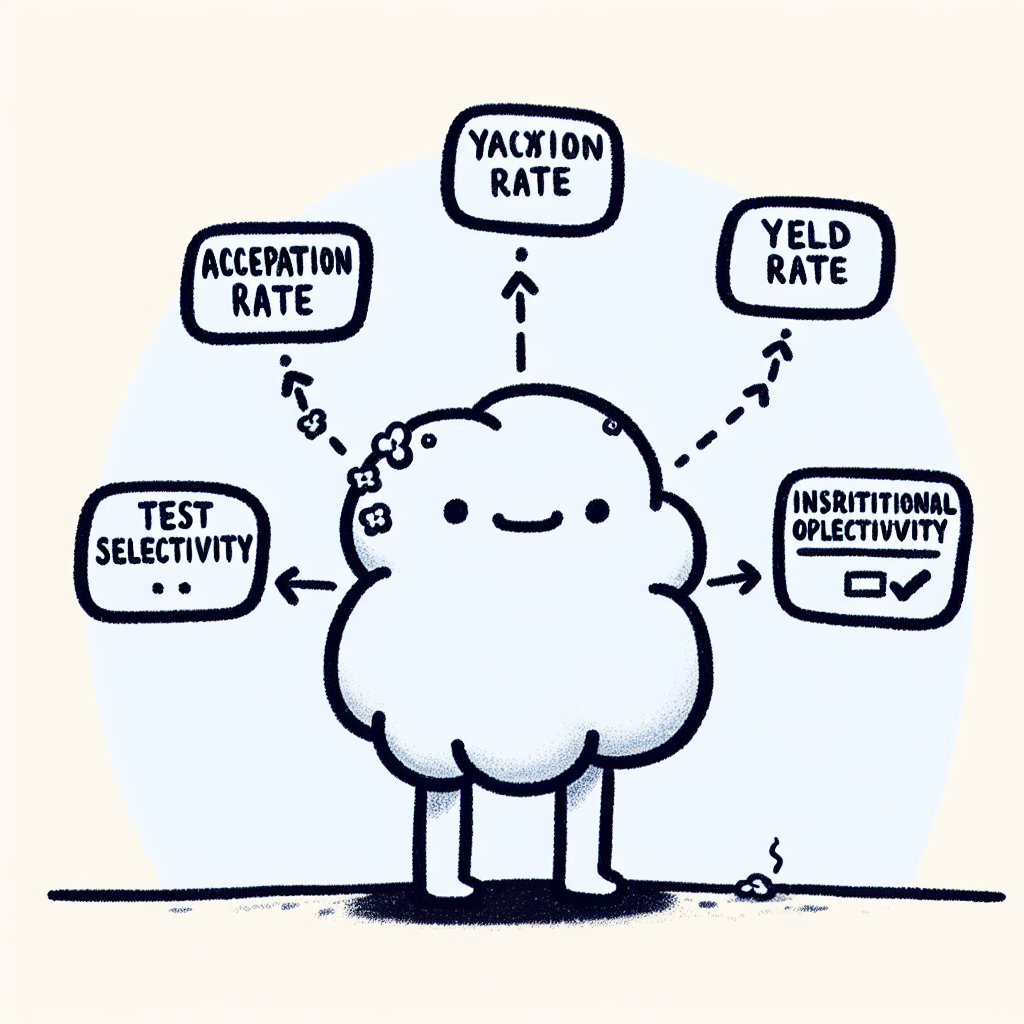Introduction
Understanding application results is essential for students, parents, and educators alike. For students, these results provide insight into how their academic and extracurricular profiles align with college expectations. Parents rely on this information to support their children in making informed decisions about where to apply and how to prepare. Educators use application outcomes to guide students effectively through the admissions process and to assess how well their school's academic programs align with college readiness standards.
Analyzing application results can reveal broader trends in college admissions, such as shifts in acceptance rates, changes in standardized testing policies, or increasing emphasis on holistic review. By examining patterns over time, stakeholders can identify which factors most influence admission decisions and how these factors differ across institutions.
Key data sources used to analyze application outcomes include reports from the Common Data Set (CDS), institutional admissions statistics published by colleges and universities, and national surveys like those conducted by the National Center for Education Statistics (NCES). These sources provide comprehensive and standardized data that help contextualize individual application results within larger trends.

📊 National-Level Data Sources
The National Center for Education Statistics (NCES)
The National Center for Education Statistics (NCES) is the primary federal entity responsible for collecting and analyzing data related to education in the United States. It plays a vital role in providing reliable and comprehensive statistics that inform education policy and research.
In the context of application results, NCES offers detailed admissions and enrollment data. This includes national acceptance rates, yield rates, and enrollment trends across various types of institutions. It also provides comparative insights between public and private colleges, helping users understand broader patterns in college admissions.
To access this data, users can navigate the NCES website, which features tools such as the College Navigator and the Digest of Education Statistics. These tools allow users to search for specific institutions or aggregate data by sector, region, or other variables. Interpreting NCES data typically involves reviewing tables and charts that outline key metrics over time. Citation: NCES
IPEDS Data Center (Integrated Postsecondary Education Data System)
The IPEDS Data Center is a major component of NCES and serves as a comprehensive source for postsecondary education statistics. Managed by NCES, IPEDS collects data from every college, university, and technical and vocational institution that participates in federal student financial aid programs.
For those examining application results, IPEDS provides access to critical admissions statistics such as first-year retention rates, standardized test score ranges, admission rates, and the number of applicants. This data is useful for comparing institutions and understanding trends in student success and selectivity.
To use the IPEDS interface, users can visit the IPEDS Data Center and search for individual institutions or generate custom data reports. The interface allows filtering by state, institution type, and other criteria to retrieve relevant data points. Citation: IPEDS Data Center
Common Data Set (CDS) Initiative
The Common Data Set (CDS) Initiative is a collaborative effort among data providers in the higher education community and publishers such as the College Board and U.S. News & World Report. Its goal is to improve the quality and consistency of information provided to the public.
CDS files include detailed application results for individual institutions. These files report the number of applicants, admits, and enrolled students, as well as waitlist statistics and ranges for GPA and standardized test scores. Such data offers transparency and allows for nuanced comparisons across institutions.
Colleges use CDS data internally for institutional research and externally for rankings and public information. The standardized format ensures that data is comparable across institutions, making it a trusted resource for students, parents, and researchers alike. Citation: Common Data Set Initiative

🏛️ Institutional Case Studies
Harvard University Admissions
Harvard University continues to report highly competitive application results, with recent years showing record-high application volumes and historically low acceptance rates. For the Class of 2027, Harvard received over 56,000 applications and admitted just 3.4% of applicants, reflecting a steady trend toward increased selectivity over the past decade.
Demographically, Harvard's admitted class reflects a diverse student body. According to its public admissions data, 29.8% identify as Asian American, 15.3% as African American or Black, 12.6% as Latinx, and 2.9% as Native American or Native Hawaiian. Gender distribution remains nearly even, and students come from all 50 U.S. states and over 90 countries, highlighting the university's global appeal.
Insights from Harvard’s admissions reports indicate that academic excellence, extracurricular distinction, and unique personal narratives are central drivers of positive application results. The institution's holistic review process considers a wide range of factors beyond test scores and GPA, contributing to its highly competitive environment (Harvard University Admissions Statistics).
University of California System
The University of California system employs a centralized approach to managing application results, publishing system-wide and campus-specific data annually. This transparency allows stakeholders to analyze trends across the nine undergraduate campuses.
Acceptance rates vary significantly within the system. For example, UCLA reported an acceptance rate of 8.8% for Fall 2022, while UC Merced accepted over 85% of applicants. This disparity reflects differences in institutional capacity, program popularity, and applicant behavior.
A major focus of the UC system has been increasing enrollment among first-generation and underrepresented students. In Fall 2022, 45% of admitted California freshmen were first-generation college students, and 39% identified as underrepresented minorities. These figures underscore the system’s commitment to equity and access in its application results (University of California Admissions Data).

Interpreting Application Results
Understanding Acceptance Rates in Context
Acceptance rates are often viewed as indicators of a college's prestige or quality, but they do not necessarily reflect the quality of education offered. A low acceptance rate can be influenced by several external factors, including the volume of applications a school receives. This phenomenon, known as application inflation, occurs as more students apply to an increasing number of schools to maximize their chances of admission. As a result, even institutions without significant changes in academic offerings or selectivity may see declining acceptance rates, which can create a misleading perception of competitiveness.
Yield Rates and Enrollment Decisions
Yield rate, the percentage of admitted students who choose to enroll, provides insight into a school's desirability among applicants. A high yield rate suggests that admitted students view the institution as a top choice. Colleges closely monitor yield rates to predict class sizes and manage resources effectively. To control yield, institutions often use strategies like early decision and early action programs, which require or encourage early commitment from applicants. Additionally, waitlists are employed as a tool to fill remaining spots and balance enrollment targets, allowing colleges to adjust based on fluctuating acceptance and yield patterns.
Demographic and Socioeconomic Factors
Application results are also shaped by factors such as race, income, and geographic location. Students from underrepresented backgrounds may face systemic barriers that affect their application outcomes, including limited access to college counseling, standardized test preparation, and extracurricular opportunities. In response, many colleges are implementing policies aimed at increasing equity and access. This includes test-optional admissions, targeted recruitment efforts, and holistic review processes that consider an applicant's context and personal background. These efforts aim to ensure that application results reflect a more inclusive and representative range of students.

Emerging Trends and Insights
The Test-Optional Shift
A growing number of colleges and universities have adopted test-optional policies, meaning applicants are no longer required to submit SAT or ACT scores. This shift has significantly influenced application results. Without standardized testing barriers, more students—particularly those from underrepresented or low-income backgrounds—are applying to selective institutions. As a result, schools have reported record-high application numbers and increased diversity in their applicant pools.
The Role of Institutional Priorities
Colleges shape their incoming classes based on a variety of institutional priorities. These can include recruiting for athletics, maintaining legacy admissions, and achieving geographic or socioeconomic diversity. These internal objectives directly affect application results, as they influence who gets admitted and how decisions are made. For example, some institutions may reserve a portion of acceptances for legacy applicants or prioritize students from underrepresented regions to meet strategic goals.
The Effects of Policy and Legislation
Policy changes at the state level also play a critical role in shaping application results. For instance, California’s Proposition 209, which banned the consideration of race in public university admissions, has had long-term effects on the demographic composition of student bodies. Similar legislative actions in other states continue to influence how universities structure their admissions strategies and evaluate applicants.

🧰 Tools and Tips for Using Application Data
Application results offer valuable insights that can help students, families, and educators make informed decisions during the college admissions process.
How Students and Families Can Use This Data
Application results can be instrumental in identifying reach, match, and safety schools. By analyzing historical admission rates and the academic profile of admitted students, families can better understand where a student stands in comparison. This helps create a balanced college list that aligns with the student’s qualifications and goals.
Resources like the Common Data Set (CDS) and the Integrated Postsecondary Education Data System (IPEDS) allow for side-by-side comparisons of colleges. These tools provide standardized information on admission rates, test scores, student demographics, and more. Using application results from these sources can help families make data-driven choices when evaluating different institutions.
For Counselors and Educators
Counselors and educators can use application results to offer evidence-backed advice tailored to each student’s profile. Instead of relying on anecdotal information, professionals can refer to actual data to guide students through the admissions process.
Additionally, application results are effective in dispelling myths about college admissions, especially at elite institutions. For example, data may show that high-achieving students from underrepresented backgrounds are being admitted at higher rates than commonly believed. Armed with this information, counselors can encourage students to apply to schools they might have otherwise ruled out.

Conclusion
Understanding application results requires more than just reading acceptance rates or test score ranges. It involves interpreting data in context—considering institutional priorities, applicant pools, and broader admission trends. By developing data literacy, students and families can make more informed decisions throughout the college admissions process.
Data literacy is essential when navigating application results. It allows applicants to critically evaluate statistics and understand what they truly represent about a college's selectivity and student body. This understanding helps set realistic expectations and build balanced college lists.
To make the best use of application results, consult reliable and transparent data sources. Reputable databases such as the National Center for Education Statistics (NCES), the IPEDS Data Center, and the Common Data Set Initiative provide comprehensive data on admissions and enrollment. Additionally, institutional sources like Harvard Admissions and the University of California Admissions offer school-specific insights into their application results.
Informed use of these tools and resources supports a clearer, more accurate understanding of the college admissions landscape.

Appendix: Glossary of Key Terms
Acceptance Rate
The percentage of applicants who are offered admission to a college or university. It is calculated by dividing the number of accepted students by the total number of applicants. The acceptance rate is a key metric used to assess application results and the selectivity of an institution.
Yield Rate
The percentage of admitted students who choose to enroll in a college or university. It is determined by dividing the number of enrolled students by the number of admitted students. Yield rate helps institutions understand the effectiveness of their admissions offers and the appeal of their programs.
Waitlist
A list of qualified applicants who may be offered admission if space becomes available. Being placed on a waitlist means the student is not currently admitted but may still receive an offer depending on final enrollment numbers. Waitlists can impact final application results for students and institutions.
Institutional Selectivity
A measure of how competitive a college or university is in admitting students. It often takes into account the acceptance rate, average test scores, and academic credentials of admitted students. Higher institutional selectivity typically correlates with lower acceptance rates and more rigorous application results.
Test-Optional Policy
An admissions policy where submitting standardized test scores, such as the SAT or ACT, is not required. Under a test-optional policy, applicants can choose whether to include test scores as part of their application. This policy can influence application results by potentially increasing the applicant pool and changing the weight of other factors in the admissions process.














